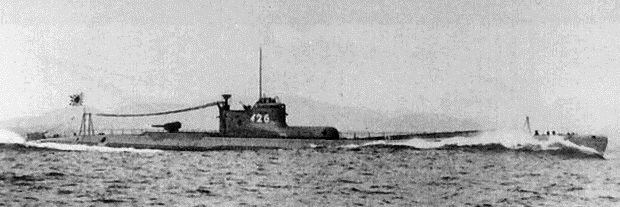Name I-26 Struck 10 March 1945 Length 109 m | Commissioned 6 November 1941 Class and type Type B1 submarine | |
 | ||
Fate Sunk in action, 26 October 1944 Displacement 2,584 tons surfaced
3,654 tons submerged | ||
Japanese submarine i 26
I-26 was a Japanese B1 type submarine which saw service in the Imperial Japanese Navy during World War II. She was completed and commissioned at the Kure Dockyard on 6 November 1941, under the command of Commander Yokota Minoru.
Contents
Patrols on the US and Canadian West Coast
On 7 December 1941, I-26 sank the 2140-ton U.S. Army chartered lumber freighter Cynthia Olson 300 nautical miles (560 km; 350 mi) off the coast of California — the first American merchant ship to be sunk by a Japanese submarine in the war. I-26 had orders not to commence hostilities until 0330 8 December (Tokyo time) -- the anticipated time of the attack on Pearl Harbor. I-26 found Cynthia Olson prior to that time, but remained submerged until surfacing near the freighter at 0330 Tokyo time (0800 7 December Hawaiian time or 0900 in the +9 time zone of the sinking.) I-26 fired a warning shell over Cynthia Olson from its 14-cm deck gun. Cynthia Olson stopped and radioed they were being attacked by a submarine. I-26 sunk Cynthia Olson by gunfire after the crew abandoned ship in lifeboats. The steamship Lurline heard the radio message from Cynthia Olson, but the crew of the sunken ship perished at sea while attention was focused on the simultaneous bombing of Pearl Harbor.
After searching unsuccessfully for the aircraft carrier USS Lexington following the attack on Pearl Harbor, I-26 patrolled off the entrance to the Strait of Juan de Fuca. A scheduled bombardment of American coastal cities on Christmas eve of 1941 was canceled because of the frequency of coastal air and surface patrols. I-26 was in Yokosuka drydock number 5 on 18 April 1942 when one of the Doolittle Raid B-25 Mitchell bombers damaged the carrier Ryūhō in the adjacent drydock number 4.
On Sunday 7 June 1942 the 3286-ton freighter Coast Trader departed Port Angeles, Washington bound for San Francisco with a cargo of newsprint. I-26 torpedoed Coast Trader as it left the Strait of Juan de Fuca that afternoon, and the ship sank in 40 minutes. One crewman died of exposure before the remainder were rescued over the following two days. The United States Navy apparently did not want to acknowledge Japanese submarine activity off the Pacific Coast during the Second Happy Time and officially attributed the sinking of Coast Trader to "an internal explosion."
In the evening of 20 June 1942, while patrolling two miles off the coast of British Columbia, I-26 surfaced and shelled the lighthouse and radio-direction-finding (RDF) installation at Estevan Point. This simple act caused a disproportionate effect on coastal shipping, as all lighthouses along the coast were then extinguished for fear of their use by enemy vessels. I-26 returned to Yokosuka on 7 July 1942.
Pacific actions
On 31 August 1942, she crippled the aircraft carrier USS Saratoga at 10°34′S 164°18′E with one torpedo hit (out of six launched).
On 13 November, during the Third Battle of the Solomon Sea (American: Naval Battle of Guadalcanal), she also hit the badly-damaged cruiser USS Juneau at 10°33′S 161°03′E. I-26’s torpedo set off Juneau’s magazine, blowing the ship in half; only ten of the 650-man crew were ultimately rescued. All five Sullivan brothers died either in the initial explosion or floating in the water awaiting rescue.
On the night of 25–26 October 1944, in the aftermath of the Battle off Samar, I-26 attacked the escort carrier USS Petrof Bay off Leyte. I-26 was sunk by either USS Coolbaugh or USS Richard M. Rowell.
The last contact with I-26 was on 25 October; she was officially presumed lost east of Leyte on 21 November 1944. I-26 was finally removed from the Navy List on 10 March 1945. I-26 was the IJN's third highest scoring submarine in terms of tonnage sunk, sinking more than 51,500 tons.
